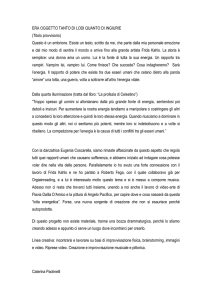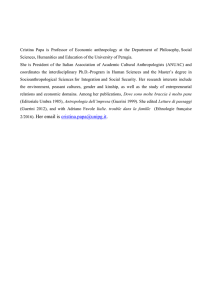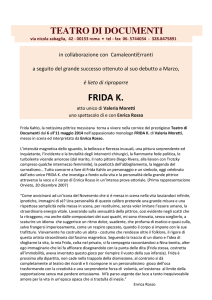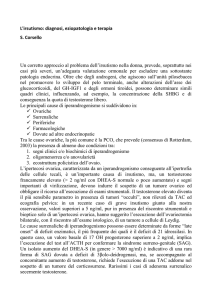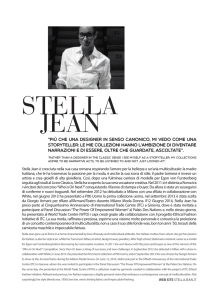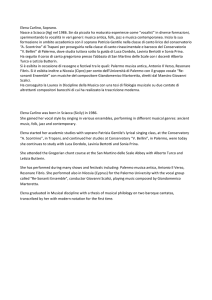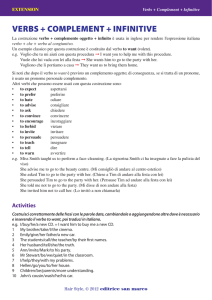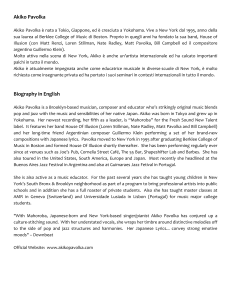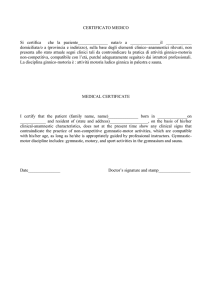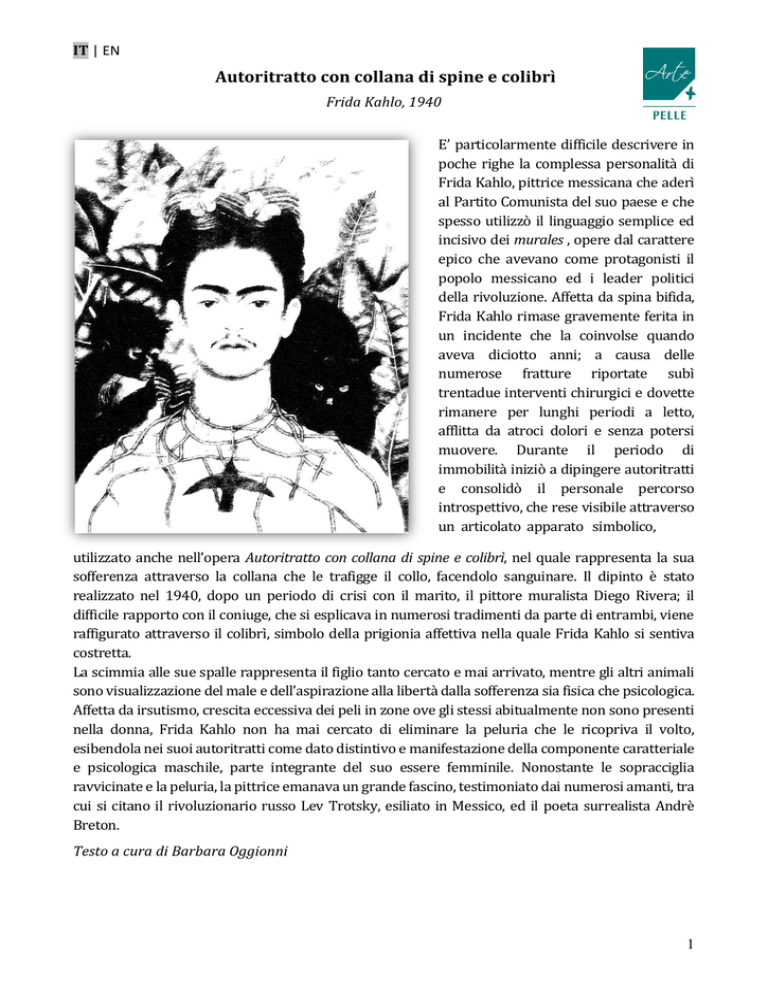
IT | EN
Autoritratto con collana di spine e colibrì
Frida Kahlo, 1940
E’ particolarmente difficile descrivere in
poche righe la complessa personalità di
Frida Kahlo, pittrice messicana che aderì
al Partito Comunista del suo paese e che
spesso utilizzò il linguaggio semplice ed
incisivo dei murales , opere dal carattere
epico che avevano come protagonisti il
popolo messicano ed i leader politici
della rivoluzione. Affetta da spina bifida,
Frida Kahlo rimase gravemente ferita in
un incidente che la coinvolse quando
aveva diciotto anni; a causa delle
numerose fratture riportate subì
trentadue interventi chirurgici e dovette
rimanere per lunghi periodi a letto,
afflitta da atroci dolori e senza potersi
muovere. Durante il periodo di
immobilità iniziò a dipingere autoritratti
e consolidò il personale percorso
introspettivo, che rese visibile attraverso
un articolato apparato simbolico,
utilizzato anche nell’opera Autoritratto con collana di spine e colibrì, nel quale rappresenta la sua
sofferenza attraverso la collana che le trafigge il collo, facendolo sanguinare. Il dipinto è stato
realizzato nel 1940, dopo un periodo di crisi con il marito, il pittore muralista Diego Rivera; il
difficile rapporto con il coniuge, che si esplicava in numerosi tradimenti da parte di entrambi, viene
raffigurato attraverso il colibrì, simbolo della prigionia affettiva nella quale Frida Kahlo si sentiva
costretta.
La scimmia alle sue spalle rappresenta il figlio tanto cercato e mai arrivato, mentre gli altri animali
sono visualizzazione del male e dell’aspirazione alla libertà dalla sofferenza sia fisica che psicologica.
Affetta da irsutismo, crescita eccessiva dei peli in zone ove gli stessi abitualmente non sono presenti
nella donna, Frida Kahlo non ha mai cercato di eliminare la peluria che le ricopriva il volto,
esibendola nei suoi autoritratti come dato distintivo e manifestazione della componente caratteriale
e psicologica maschile, parte integrante del suo essere femminile. Nonostante le sopracciglia
ravvicinate e la peluria, la pittrice emanava un grande fascino, testimoniato dai numerosi amanti, tra
cui si citano il rivoluzionario russo Lev Trotsky, esiliato in Messico, ed il poeta surrealista Andrè
Breton.
Testo a cura di Barbara Oggionni
1
IT | EN
Irsutismo
L'irsutismo è per definizione un problema solo femminile.
Si tratta di un'eccessiva crescita di peli con caratteristiche
e distribuzione tipicamente maschili con peli grossi e
pigmentati su aree del corpo sensibili all’azione degli
ormoni sessuali maschili, gli androgeni. Le zone in cui i peli
aumentano sono quelle ormono-sensibili, cioè mento,
labbro superiore, petto, addome (in particolare sulla linea
mediana o linea alba), spalle, cosce e avambraccia.
L’irsutismo va distinto dall’ipertricosi che è un eccessivo
sviluppo di peluria in tutte le regioni del corpo senza
concentrazione in determinate zone. Mentre l’ipertricosi
non è causata da squilibri endocrini, l’irsutismo può essere
la manifestazione di una malattia endocrina con un
eccesso nella produzione degli androgeni che, nella donna,
sono prodotti dall’ovaio e dalle ghiandole surrenali. Tra le
alterazioni endocrine associate a irsutismo, la più
frequente è la cosiddetta “sindrome dell’ovaio policistico”.
Anche alcuni farmaci come gli ormoni anabolizzanti
possono essere responsabili di irsutismo. In presenza di
disturbi endocrini, l'irsutismo si può accompagnare ad
alterazioni del ciclo mestruale, a sovrappeso o obesità,
acne e perdita di capelli, alterazioni del tono della voce,
aumento della massa muscolare e altri segni di
virilizzazione.
In un certo numero di casi, una causa per l'irsutismo non è
identificabile e si parla allora di irsutismo idiopatico. In
queste forme in cui l’assetto ormonale è del tutto normale
sembra esserci un'aumentata sensibilità del follicolo
pilifero all’ormone maschile.
La gestione clinica dell'irsutismo impone che venga
esclusa o rimossa una causa ormonale. Per migliorare
l’aspetto estetico possono essere di aiuto trattamenti
cosmetici come l'elettrolisi e la depilazione laser. Una dieta
ipocalorica e a basso indice glicemico va considerata nei
casi in cui all’irsutismo si associ un disordine del
metabolismo dell’insulina, come spesso accade nella
sindrome dell’ovaio policistico.
Le fasi di crescita del pelo che si succedono
regolarmente e in maniera sfasata tra un
follicolo e l'altro.
Un manipolo per l'epilazione laser. Il laser più
comunemente impiegato è il laser alessandriteNdYAG.
Testo a cura di Marzia Bronzoni e Luigi Naldi
2
IT | EN
Self portrait with thorn necklace and hummingbird
Frida Kahlo, 1940
Mathis It is difficult to describe in just a
few lines the complex character of Frida
Kahlo, the Mexican painter who joined
the Communist Party of her country and
often used the simple but incisive
language of the murales, works of an epic
nature depicting the Mexican people and
political leaders of the revolution.
Afflicted with spinabifida, Frida Kahlo
was badly injured in an accident when
she was eighteen; because of the large
number of fractures, she underwent
thirty two operations and was confined
to bed for long periods of time suffering
atrocious pain and unable to move.
During this period of immobility she
began to paint self portraits and
strengthened the path of her inner self
rendering it visible through a well
structured system which she employed
in the work Self portrait with thorn
necklace and hummingbird, in which she depicts her suffering in the necklace that pierces her neck
making it bleed. It was painted in 1940 after a period of crisis with her husband, the mural painter
Diego Rivera; the complicated relationship of the spouses, who both had numerous affairs, is
represented by the hummingbird, a symbol of emotional imprisonment which Frida Kahlo felt she
was constrained to.
The monkey on her shoulders represents the child she desperately wanted but never had, while the
other animals are a vision of the pain and of her aspiration to be free of both physical and
psychological suffering. Afflicted by hirsutism, excessive growth of hairs where they don’t usually
grow on women, Frida Kahlo never tried to remove the hairs that covered her face, depicting them
in her self portraits as a distinguishing feature and a male component of her character and psyche.
An integral part of her feminine self. Despite her eyebrows being very close to each other and the
hairs on her face, she effused great charm as is testified by the numerous lovers she had, among
whom were the Russian revolutionary Lev Trotsky, in exile in Mexico, and the surrealist poet Andrè
Breton.
Text edited by Barbara Oggionni
Translation by Gordon Frickelton
3
IT | EN
Hirsutism
Hirsutism is by definition a problem that only women
have. It consists of the excessive growth of hairs
distributed in a typically male fashion with thick, dark
hairs in areas of the body that are sensitive to the male
sexual hormones, the androgens. The areas where the
hairs appear are those sensitive to hormones, that is the
chin, the upper lip, the chest, the abdomen (especially
around the middle or the linea alba), shoulders, thighs and
forearms.
Hirsutism is distinct from hypertrichosis which is the
excessive growth of hair where it normally grows in
women. While hypertrichosis is caused by an imbalance in
the endocrines, hirsutism can be an indicator of an
endocrinous disease causing the excess production of
androgens which, in women, are produced by the ovaries
or the adrenal glands. The most frequent of these overall is
the so called “polycystic ovary syndrome”. Some
medicines such as steroids can also be the cause of
hirsutism. When there are endocrinous disturbances,
hirsutism can be associated with alteration of the
menstrual cycle, overweight and obesity, acne and hair
loss, change in the tone of voice, increase in body muscle
and other signs of masculinity.
In a certain number of cases the cause of hirsutism cannot
be ascertained and is referred to as idiopathic hirsutism
(without known cause). In this form of the disease the
hormone balance is totally normal and there seems to be
an increase in the sensitivity to the male hormone of the
hair follicle.
The clinical therapy for hirsutism necessitates the
exclusion or removal of the hormone causing it. From an
aesthetic point of view, cosmetic solutions can be helpful,
such as electrolysis and laser depilation. A hpocaloric diet
with low glycemic levels is often adopted when the
disturbance is due to the metabolism of insulin, as is
frequently the case of the polycystic ovary syndrome.
The phases of growth of the hair which follow
one another and are out-of-phase with the
other follicles.
A laser wand for hair removal. The most
common type of laser used is the alessandriteNdYAG.
Text edited by Marzia Bronzoni and Luigi Naldi
Translation by Gordon Frickelton
4

